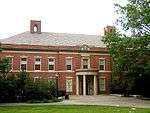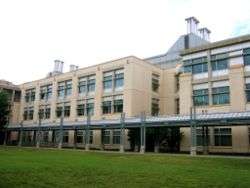Edmund T. Pratt Jr. School of Engineering
 | |
Parent institution | Duke University |
|---|---|
Academic staff | 130[2] |
| Undergraduates | 1,234[2] |
| Postgraduates | 976[2] |
| Location | Durham, North Carolina, United States |
| Website | Duke Engineering |
Duke's Pratt School of Engineering[2] is one of two undergraduate schools at Duke University in Durham, North Carolina, United States. The other is the Trinity College of Arts and Sciences. It is also one of ten graduate and professional schools at Duke.
Pratt awards undergraduate degrees in biomedical engineering, civil and environmental engineering, electrical and computer engineering, and mechanical engineering and materials science. A Master of Engineering Management degree and a Master of Engineering degree are also offered. The degrees of Master of Science and Doctor of Philosophy are awarded by the Duke Graduate School for all four departments.
As of the fall 2016 semester, Pratt's student body consists of 1,234 undergraduates and 976 graduate students, taught by a faculty of 130.[3]
The majority of Pratt's faculty, labs, and courses can be found in Hudson Hall, the Nello L. Teer Building, the Fitzpatrick Center for Interdisciplinary Engineering, Medicine and Applied Sciences (also known as FCIEMAS), the North Building and the Levine Science Research Center (also known as the LSRC).
In 2006, the Pratt School's graduate program was ranked as the second best engineering graduate program in the country by The Princeton Review.[4]
Until 2007, Kristina M. Johnson was the dean of Pratt, becoming the first woman to hold the position in 1999. After Johnson left to become the provost of Johns Hopkins University, Robert L. Clark became dean pending a national search for Johnson's replacement. Thomas Katsouleas of the University of Southern California was announced as dean in spring of 2008 and started on July 1, 2008.[5] Ravi Bellamkonda, previously of the Wallace H. Coulter Department of Biomedical Engineering at Georgia Tech and Emory University, was announced as the next Vinik Dean of Engineering at Duke on January 26, 2016. He became dean on August 1, 2016.[6]
History
The precursor to the school of engineering dates back to 1851, when Duke was known as Normal College and located in Randolph County, North Carolina. At that time, engineering was included in a Classical course for seniors. A course in engineering was later introduced in 1887, eventually becoming a regular course offering in 1903. At that time, engineering courses were limited to such fields as architecture and surveying, until 1924 when Trinity College was renamed to Duke University. Engineering then underwent a major change becoming separate departments of civil and electrical engineering. Seven years later, in 1931, a mechanical engineering department was created. Duke's Board of Trustees then decided to create the College of Engineering in 1939, with William H. Hall becoming its first dean.
The College of Engineering graduated its first class of women in 1946. The next year, the three departments moved from East Campus to their current location on West Campus. The college was then named the School of Engineering in 1966. Two years later, in 1968, the school's first black students graduated. The Division of Biomedical Engineering was created in 1967, becoming the first accredited biomedical engineering department of a U.S. university in September 1972[7]
Later, in 1997, the Master of Engineering Management was established. The Duke University School of Engineering was renamed the Edmund T. Pratt, Jr. School of Engineering in 1999, in honor of Edmund T. Pratt, Jr., a 1947 graduate of the school and former CEO of Pfizer.
Buildings
| Hudson Hall | |
|---|---|
 | |
| Former names | Old Red |
| General information | |
| Type | University Hall |
| Architectural style | Georgian |
| Location | West Campus, Duke University |
| Current tenants | Engineering school |
| Named for | Fitzgerald S. "Jerry" Hudson |
| Opened | 1948 |
| Design and construction | |
| Architect | Office of Horace Trumbauer[8] |
Hudson Hall is the oldest engineering building at Duke University, serving as the main hub for the School of Engineering. Constructed in 1948, Hudson Hall was renamed to honor Fitzgerald S. "Jerry" Hudson (E'46) in 1992.[9]
The Nello L. Teer Library Building opened in 1984. Located directly next to Hudson Hall, the structure, now called the Teer Engineering Building, houses the Dean's office and school administrative offices, a computing lab as well as circuits labs, an auditorium and a student lounge.[9]
The Fitzpatrick Center for Interdisciplinary Engineering, Medicine and Applied Sciences - often referred to as FCIEMAS - opened in August 2004. Research facilities focus on the fields of photonics, bioengineering, communications, and materials science and materials engineering. The aim of the building was to emphasize interdisciplinary activities and encourage cross-departmental interactions. The building houses numerous wet bench laboratories (highlighted by a world-class nanotechnology research wing), offices, teaching spaces, and a café.[9] FCIEMAS is also home to the Master of Engineering Management Program. The construction of FCIEMAS took more than three years and cost more than $97 million.
The Levine Science Research Center (LSRC) is a 341,000-square-foot (31,700 m2) facility. When it was opened in 1994, the LSRC was the largest single-site interdisciplinary research facility in the U.S.. Its classrooms are shared by several departments, but the majority of its offices and laboratories are utilized by the Nicholas School of the Environment, the Pratt School of Engineering, the Center for Cognitive Neuroscience and Developmental and the departments of Computer Science, Pharmacology and Cancer Biology and Cell and Molecular Biology.[10] The building was named for Leon Levine, the CEO of Family Dollar Stores.[9]
 Hudson |
 Teer |
Deans
Deans of the school are as follows:[11]
- William H. Hall, 1939-1953
- Walter J. Seeley, 1953-1962
- James L. Meriam, 1962-1969
- George Pearsall, 1969-1974, 1982-1983
- Aleksandar Vesic, 1974-1982
- Earl Dowell, 1983-1999
- Kristina M. Johnson, 1999-2007
- Robert L. Clark, 2007-2008
- Thomas Katsouleas, 2008–2015
- George Truskey, 2015-2016
- Ravi Bellamkonda, 2016-Present
Notable alumni
See also
Notes
- ↑ "Duke Engineering - Duke Pratt School of Engineering".
- 1 2 3 4 "Duke Engineering at a Glance - Duke Pratt School of Engineering".
- ↑ "About Pratt School of Engineering". Duke University. Retrieved August 25, 2016.
- ↑ The Princeton Review Releases Its First-Ever Ranking of the Nation's Top Graduate Engineering Programs, Marketwire
- ↑ Katsouleas Named Dean at Duke's Pratt School of Engineering, Office of Duke News and Communication, March 6, 2008
- ↑ "Duke University Names New Engineering School Dean - Duke Pratt School of Engineering".
- ↑ Biomedical Engineering Celebrates 30 Years, Pratt School of Engineering, November 2001
- ↑ Engineering News-Record 1946: 148.
- 1 2 3 4 About Pratt Facilities
- ↑ "Duke University Maps".
- ↑ Our History, Pratt School of Engineering
External links
Coordinates: 36°00′14″N 78°56′25″W / 36.0040°N 78.9403°W


